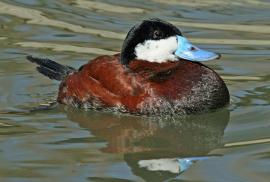Guide to Boreal Birds
Overview
This duck is one of the most aquatic members of the family and like a grebe can sink slowly out of sight. Although it can avoid danger by diving or by hiding in marsh vegetation, it is a strong flier and undertakes long migrations to and from its nesting places. Largely vegetarian, it favors pondweed and the seeds of other aquatic plants, but also consumes large numbers of midge larvae during the breeding season.
Description
14-16" (36-41 cm). A small, chunky duck with a long tail that is often held straight up. Male in breeding plumage has chestnut body, black crown, and white cheeks. Female and winter male are dusky brown, with whitish cheeks of female crossed by a dark stripe. Male's bill is blue in breeding season, black at other times.
Voice
Usually silent. Courting male produces ticking and clapping sounds by pressing its bill against its breast.
Nesting
6-20 white or cream-colored eggs in a floating nest of dry stems lined with down, concealed among reeds or bulrushes in a marsh.
Habitat
Breeds on freshwater marshes, marshy lakes, and ponds; winters on marshes and in shallow coastal bays.
Range/Migration
Breeds from British Columbia, Mackenzie, and Quebec south to California, southern New Mexico, and southern Texas, with occasional breeding farther east. Winters on coasts north to British Columbia and Massachusetts and as far inland as Missouri.



